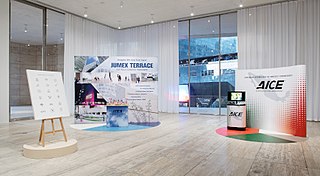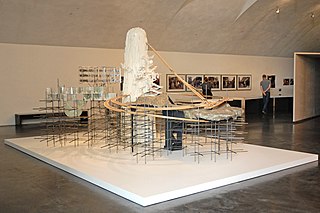Related Research Articles
Video art is an art form which relies on using video technology as a visual and audio medium. Video art emerged during the late 1960s as new consumer video technology such as video tape recorders became available outside corporate broadcasting. Video art can take many forms: recordings that are broadcast; installations viewed in galleries or museums; works streamed online, distributed as video tapes, or DVDs; and performances which may incorporate one or more television sets, video monitors, and projections, displaying live or recorded images and sounds.

Performance art is an artwork or art exhibition created through actions executed by the artist or other participants. It may be witnessed live or through documentation, spontaneously developed or written, and is traditionally presented to a public in a fine art context in an interdisciplinary mode. Also known as artistic action, it has been developed through the years as a genre of its own in which art is presented live. It had an important and fundamental role in 20th century avant-garde art.
Madeline Charlotte Moorman was an American cellist, performance artist, and advocate for avant-garde music. Referred to as the "Jeanne d'Arc of new music", she was the founder of the Annual Avant Garde Festival of New York and a frequent collaborator with Korean American artist Nam June Paik.

Shigeko Kubota was a Japanese video artist, sculptor and avant-garde performance artist, who mostly lived in New York City. She was one of the first artists to adopt the portable video camera Sony Portapak in 1970, likening it to a "new paintbrush." Kubota is known for constructing sculptural installations with a strong DIY aesthetic, which include sculptures with embedded monitors playing her original videos. She was a key member and influence on Fluxus, the international group of avant-garde artists centered on George Maciunas, having been involved with the group since witnessing John Cage perform in Tokyo in 1962 and subsequently moving to New York in 1964. She was closely associated with George Brecht, Jackson Mac Low, John Cage, Joe Jones, Nam June Paik, and Ay-O, among other members of Fluxus. Kubota was deemed "Vice Chairman" of the Fluxus Organization by Maciunas.

Michael Smith is an American artist known for his performance, video and installation works. He emerged in the mid-1970s at a time when performance and narrative-based art was beginning to claim space in contemporary art. Included among the Pictures Generation artists, he also appropriated pop culture, using television conventions rather than tropes from static media. Since 1979, much of Smith's work has centered on an Everyman character, "Mike," that he has portrayed in various domestic, entrepreneurial and artistic endeavors. Writers have described his videos and immersive installations as "poker-faced parodies" that sit on the edge between art and entertainment, examining ideas, cultural shifts and absurdities involving the American dream, consumerism, the art world, and aging. Village Voice critic Jerry Saltz called Smith "a consummate explorer of the land of the loser … limning a fine line between reality and satire [in] a genre sometimes called installation verité."
Judy Dunaway is a conceptual sound artist, avant-garde composer, free improvisor and creator of sound installations who is primarily known for her sound works for latex balloons. Since 1990 she has created over thirty works for balloons as sound conduits and has also made this her main instrument for improvisation.

Earl Howard is an American avant-garde composer, arranger, saxophonist, synthesizer player and multi-instrumentalist.

Lee Bul is a contemporary sculpture and installation artist who appeared on the art scene in the late 1980s. Her work questions patriarchal authority and the marginalization of women by revealing ideologies that permeate our cultural and political spheres.
Dawn Kasper is a New York-based interdisciplinary artist working across genres of performance, installation, sculpture, drawing, photography, video, and sound. Her often improvisational work derives from a "fascination with existentialism, subjects of vulnerability, desire, and the construction of meaning." Kasper uses props, costume, comedy, gesture, repetition, music, and monologue to create what she refers to as "living sculptures."
Digital Performance refers to the use of computers as an interface between a creator, and consumer of images, and sounds in a wide range of artistic applications. It is performance that incorporates and integrates computer technologies and techniques. Performers can incorporate multimedia into any type of production whether it is live on a theatre stage, or in the street. Anything as small as video recordings or a visual image classifies the production as multimedia. When the key role in a performance is the technologies, it is considered a digital performance. This can be as simple as making projections on a screen for a live audience or as complex as planning and putting on a show online.
Charlie Morrow is an American sound artist, composer, conceptualist and performer. His creative projects have included chanting and healing works, museum and gallery installations, large-scale festival events, radio and TV broadcasts, film soundtracks, commercial sound design and advertising jingles.
Sharon Hayes is an American multimedia artist. She came to prominence as an artist and an activist during the East Village scene in the early '90s. She primarily works with video, installation, and performance as her medium. Using multimedia, she "appropriates, rearranges, and remixes in order to revitalize spirits of dissent". Hayes's work addresses themes such as romantic love, activism, queer theory, and politics. She incorporates texts from found speeches, recordings, songs, letters, and her own writing into her practice that she describes as “a series of performatives rather than performance.”
Nina Sobell is a contemporary sculptor, videographer, and performance artist. She began creating web-based artworks in the early 1990s.
Adrianne Wortzel is an American contemporary artist who utilizes robotics in her installations and performances. She has also created many online works.
Cynthia Marie "Tina" Girouard was an American video and performance artist best known for her work and involvement in the SoHo art scene of the 1960s and early 1970s.
Barbara London is a US curator and writer specializing in new media and sound art. She is best known for founding the video collection at the Museum of Modern Art (MoMA), and for the leading acquisition of works by Nam June Paik, Laurie Anderson, Bruce Nauman.
Julianne Swartz is a New York-based artist who works with sound, kinetics, and other materials to make sculpture, installations and photographs. Swartz uses optics, magnetism, and the concepts of space and time in her body of work. Swartz uses lights, mirrors, magnets, periscopes, and the concepts of space and time in her body of work, which has been exhibited at the Brooklyn Museum of Art, MoMA PS1, New Museum, Indianapolis Museum of Art, and the 2004 Biennial exhibition at the Whitney Museum. Her awards include the Joan Mitchell Foundation Painters and Sculptors Award (2008) and the American Academy of Arts and Letters Academy Award in Art (2010).

Nina Yankowitz is an American visual artist known for her work in new media technology, site specific public works, and installation art. She is a National Endowment for the Arts fellow, and a Pollock-Krasner Foundation Award recipient.
Hilja Keading is an American artist primarily working in the field of video art.
Angel Nevarez and Valerie Tevere are a pair of artists that have been collaborating on video, sound, performance and installation projects since 2001. Several of their projects have been produced under the collective name neuroTransmitter. Their art works often incorporate popular music and examine how visual forms traverse and are complicated once they are at play in public spaces.
References
- ↑ Whitney Museum of American Art (1988). Bulletin of the Whitney Museum of American Art, 1987–1988. Frances Mulhall Achilles Library Whitney Museum of American Art. Whitney Museum of American Art.
- ↑ "Article". lizphillips.net.
- ↑ Girrl Sound | http://girrlfeaturedartistslizphillips.blogspot.com/%7Caccessdate=15%5B%5D April 2014
- ↑ Rabinowitz, Paula (September 2002). "The Sound of Reformed Space: Liz Phillips's Responsive Installations". PAJ: A Journal of Performance and Art. 24 (3): 35–43. doi:10.1162/15202810260186639. JSTOR 3246345. S2CID 57564016.
- ↑ Phillips, Liz (1971). "Sound Structures" (PDF). Radical Software. 1 (3): 8. Retrieved April 15, 2014.
- 1 2 Phillips, Liz (2009). "Harnessing Waves and Elastic Space" (PDF). Leonardo Music Journal. 19: 57–62. doi:10.1162/lmj.2009.19.57. S2CID 57559455 . Retrieved April 15, 2014.
- ↑ "EAI Archives Online: A Kinetic History". Archived from the original on November 20, 2010. Retrieved April 15, 2014.
- ↑ Keefe, Alexander. "Aleph Null". Bidoun. Retrieved April 15, 2014.
- ↑ Morrow, Charlie (March 7, 1974). "Liz Phillips". The SoHo Weekly News . Retrieved April 15, 2014.
- ↑ "The Talk of the Town". New Yorker. April 18, 1977.
- ↑ Rockwell, John (May 14, 1981). "Avant-Garde: Liz Phillips Sound". New York Times. Retrieved April 15, 2014.
- ↑ Ahlstrom, David (Fall 1982). "Liz Phillips: Sun Spots". Computer Music Journal. 6 (3). Retrieved April 15, 2014.
- ↑ New York Media, LLC (March 7, 1988). "Gallery listings". New York Magazine. Retrieved April 15, 2014.
- ↑ Ratcliff, Carter (2002). The Magic of Light. Hudson River Museum. p. 24.
- ↑ Foran, Jack. "Reprising Artpark at UB". Artvoice. Retrieved April 15, 2014.
- ↑ "Liz Phillips' Biyuu" . Retrieved April 15, 2014.
- ↑ "Biyuu by Liz Phillips" . Retrieved April 15, 2014.
- ↑ "Queens Museum".
- ↑ Liebson, Rebecca (February 14, 2020). "Global Entry Ban: The Feud Between Trump and New York". The New York Times.
- ↑ "NewMusicUSA: Supporting the Sounds of Tomorrow".
- ↑ Johnson, Ken (2003). "ART REVIEW; Hanukkah With Neon And Bulbs On a Grid". The New York Times. ISSN 0362-4331 . Retrieved March 22, 2018.